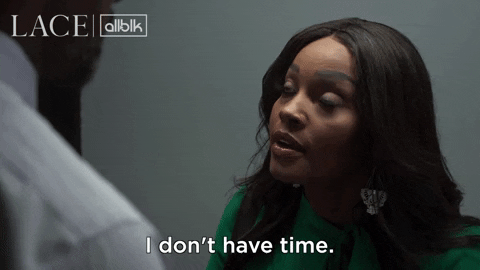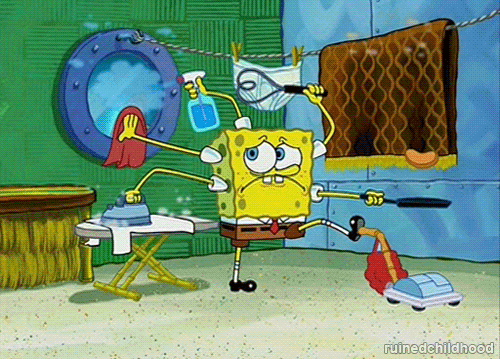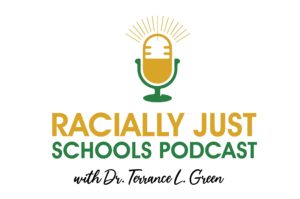Time is one of the most precious resources that we have in life, and of course, in the work that we do in schools.
However, I constantly hear teachers and school leadership teams say things like, “I wish we had more time and resources for racial justice work at my school.”
I get it.
If when you think about the time you have and feel like this, then you’re not alone:

But since we can’t create more time, we must look at the time and resources that we currently have and reimagine how we might use them differently towards more racially just ends.
One resource that most schools have which can be reimagined for racial justice is Professional Learning Communities (PLC).
What are Professional Learning Communities (PLCs)?
A Professional Learning Community or what is commonly known as a PLC is a group of educators that meet regularly, share expertise, and work collaboratively to improve teaching skills and the academic performance of students (edglossary.org). Put simply, as Shirly Hord, describes, a Professional Learning Community is “professionals coming together in a group–a community–to learn.”
However, given the day-to-day demands placed on educators and leadership teams, it is very easy for PLCs to end up being “just another meeting.”
I can attest to this.
When I was a teacher, despite our best intentions, there were times when our PLC time ended up becoming filled with last minute lesson planning, grading papers, eating lunch, and any other urgent task that we had to complete.
If your Professional Learning Community has ever felt like this picture below, with all the multitasking that you’re doing, I feel you.

Despite the many urgent tasks that you need to complete, the good news is that if leveraged properly, PLCs can become a powerful force for advancing racial justice in your school. To make this a reality, I am going to share with you four ways to help make your Professional Learning Community focus on racial justice.
I have so much to share with you on this topic that I am going to make this a four-part series. Here, I’ll share one practice with you and the other practices in a subsequent article (I am even going to make an entire podcast about this).
Let’s get started.
#1) Constantly Create the Environment for Racial Justice
Environments are important for growth. Just like you can’t grow apples in the desert, you can’t cultivate deep and transformative racial justice work in districts or schools with people who don’t have radical trust with each other and relationships that move beyond unequal power dynamics. These types of relationships are imperative to building racially just schools because this work is meant to be pursued collectively, not individually or in isolation. So in creating an environment in your PLC for racial justice, here are a few things you and your team might consider.
First, establish some collective agreements or commitments that you will practice to guide your collective work. Setting collective agreements early on is imperative because it allows everyone to contribute to how they want the space to feel, look, sound and be. However, when creating collective agreements it is important to understand and name how people’s identities can inform how they show up in spaces. In other words, you and your group should pay attention to the historic and contemporary ways that people from minoritized communities are often marginalized in group settings because of their race, ethnicity, gender, gender identity, sexual orientation, religion, and any other socially constructed marker of difference. Therefore, it would help to have group agreements that name and work to disrupt these dynamics.
"You can’t cultivate deep and transformative racial justice work in schools with people who don’t have radical trust with each other and relationships that move beyond unequal power dynamics."
While establishing collective agreements, your community should have conversations about what it means to be in a radically brave space and not necessarily a safe space that is meant to make white people feel comfortable. However, at the same time, your group might also discuss and grapple with the reality that people from minoritized communities should feel a sense of safety within these spaces. In other words, for example, this means that Black women should not feel like the PLC discredits their knowledge, expertise, wisdom, feelings, or experiences.
One last point here. It would help your group to develop agreements about how you will restoratively address situations when (not if) someone transgresses your agreements.
Some Additional Practical Steps for your Professional Learning Community
Second and similar to the first suggestion: clearly communicate the expectations for the group. What is the expectation for what the PLC is supposed to learn? Regardless of what it is, I’d encourage you to make sure that it is aligned with working towards racial justice. For example, if your PLC is focused on instruction, then you don’t just want to be learning about how you engaged in instruction but rather how your instruction works towards broader efforts of racial justice. You might consider the implications of racial justice on instruction, assessments, planning, team teaching, to name a few.
Third, in setting the environment of your PLC it is important to make sure that you distribute responsibilities equitably, not necessarily equally. This means that you should clearly communicate and discuss what responsibilities are needed for your PLC to achieve its goals and figure out ways for people to equitably contribute towards those ends that lifts up their manifold expertise.
Fourth, make learning time participatory and not passive. It still amazes me that in school districts so many educators still overwhelmingly make learning passive and lecture-based. It’s the old “sit and get” banking model of education. This does not create space for people to be active participants in collective learning.
A Few Critical Questions
Finally, you might consider varying ways of learning that tap into the collective and holistic nature of your community. In other words, this means that your learning should be expansive enough to engage people emotionally, culturally, and experientially.
So to recap, here are four questions that your PLC should grapple with:
- How and in what ways have we intentionally created an environment in our PLC where transformative racial justice can happen? What evidence do we have to support our answers?
- Have we set collective agreements for how we want our PLC to feel, look, sound and be? If so, what does it include? And how will we restore each other and the process when someone transgresses?
- What are our racial justice expectation for our PLC?
- How will we distribute the responsibilities of our PLC equitably?
- How might we constantly make learning participatory in our PLC?
- How might we make learning in our PLC expansive enough to tap into people’s racial, cultural and experiential knowledge?
Stay tuned for part 2 of this series.

I want to to thank you for this good read!! I certainly enjoyed every bit of it. I’ve got you book-marked to look at new stuff you postÖ
Thank you very much. I really appreciate it.
Really appreciate you sharing this blog article.Really looking forward to read more. Really Great.
Thank you very much. I really appreciate it.
Hola! I’ve been following your blog for some time now and
finally got the courage to go ahead and give you a shout out from Kingwood Texas!
Just wanted to tell you keep up the great job! chelsea tröja herr
JeffreyLa norge bortedrakt ErrolPere
Thank you very much.